There are 9 bilateral points on the pericardium channel: 1 on the chest; 8 along the midline of the medial side of the upper limbs. The first is in the fourth intercostal space, PC 1 (tiān chí); the last is at the tip of the middle fnger, PC 9 (zhōng chōng). Points of this channel treat heart, chest, emotional, brain, nervous system, and circulatory system disorders and those of the running course.
PC 1 (Tiān Chí, 天池)
Intersecting point of the hand jueyin and foot shaoyin channels
Location. On the anterior thorax in the fourth intercostal space and 5 cun lateral to the anterior median line (Pic. 3-61).
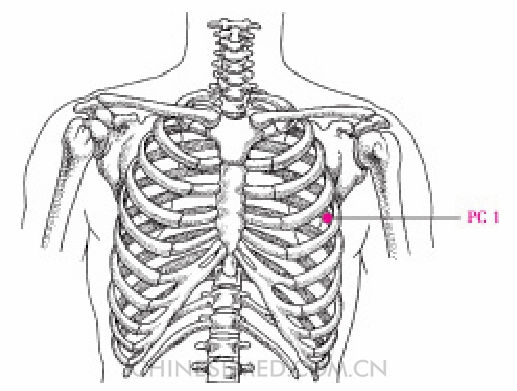
Actions. Invigorate blood and dissolve stasis, relieve cough and panting, dissolve phlegm, and dissipate masses.
Indications. Cough, asthma, vomiting, chest pain, chest distress, vexation, other lung and heart disorders; scrofula; acute mastitis, insufficient lactation; armpit swelling and pain.
Manipulation. Acupuncture: Needle obliquely or transversely 0.3~0.8 cun toward the lateral side of the chest to produce local soreness and distention. Deep insertion can cause pneumothorax. Moxibustion: Use 3~5 cones of cone moxibustion or use a moxa stick for 5~10 minutes.
Precautions. Needle along the long axis of the ribs; perpendicular insertion is prohibited. Avoid piercing the intercostal muscle in order not to damage the parietal pleura. Care must be taken to protect the breasts when using this point in pregnant and lactating women.
Annotation. The point appeared in The Spiritual Pivot-Fundamental Points (Líng Shū-Běn Shū,灵枢·本输). Tiān, heaven, means high position; chí, pool, is a place where water gathers. The point receives qi of the foot shaoyin channel; located near the breast, which produces milk, it is like a pool. Hence the name, tiān chí, heaven’s pool.
PC 2 (Tiān Quán, 天泉)
Location. On the medial aspect of the arm between the long and short heads of the biceps brachii muscle, 2 cun distal to the anterior axillary fold (Pic. 3-62).
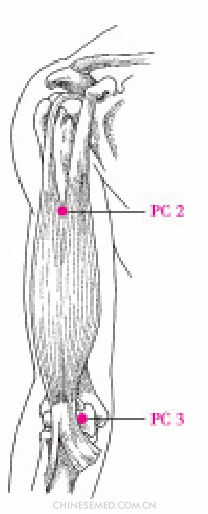
Location.method. With the patient’s arm extended palm upward, the point is 7 cun above the transverse cubital crease on a line from the top of the anterior axillary fold to PC 3 (qū zé) in the crease.
Actions. Invigorate blood and unblock the channel, rectify qi and relieve pain.
Indications. Cough, asthma, chest distress, vexation, chest pain, distention, fullness of chest and hypochondrium, other heart and lung disorders; chest and back pain, medial upper arm pain.
Manipulation. Acupuncture: Needle perpendicularly 0.5~0.8 cun, Local soreness and distention can radiate to the shoulder. Moxibustion: Use 3~5 cones of cone moxibustion or warming needle moxibustion, or use a moxa stick for 5~10 minutes.
Precautions. Avoid strong twirling so as not to pierce the small blood vessels.
Annotation. The point appeared in The Systematic Classic ofAcupuncture and Moxibustion (Zhēn Jiŭ Jiă Yĭ Jīng, 针灸甲乙经) and is located on the upper part of the arm. Tiān, heaven, means upper part; quán; spring, is a place where water comes forth. Because this point receives qi from PC 1 (tiān chí) like water gushing out and falling into a pool, the point is called tiān quán, heaven’s spring.
PC 3 (Qū Zé, 曲泽)
He-sea point
Location. On the medial aspect of the elbow at the cubital crease in the depression medial to the biceps brachii tendon (Pic. 3-62).
Location.method. The point can be only located with the elbow slightly fexed.
Actions. Clear summerheat, supplement and boost heart qi, unblock channels, invigorate collaterals, clear heat, and resolve toxins.
Indications. Heart pain, terror, palpitations, vexation, other heart disorders; acute gastric disorders such as stomachache, vomiting, hematemesis, cholera; summerheat disorders; pulling pain of the elbow and arm, inability to extend elbow and arm.
Manipulation. Acupuncture: 1. Needle perpendicularly 0.5~1.0 cun. Local heaviness and distention can radiate to the middle fnger. 2. Bleeding with a three-edged needle may be used for heatstroke, high fever, and acute gastroenteritis. Moxibustion: Use 3~5 cones of cone moxibustion, or use warming needle moxibustion for 20 minutes, or a moxa stick for 5~10 minutes.
Precautions. 1. Compress the medial side of the tendon of the biceps brachii muscle with the tip of your fnger, making sure to move the blood vessels and nerves away from the tendon. Insert the needle along the medial side of the tendon; do not lift, thrust, or twirl repeatedly. 2. Only bleed small veins with the three-edged needle, not large ones such as the basilic vein. 3. Scarring moxibustion is forbidden.
Annotation. The point appeared in The Spiritual Pivot-Fundamental Points (Líng Shū-Běn Shū,灵枢·本输). Qū means to bend; zé, marsh, is a place where water gathers. This is the he-sea point of the hand jueyin channel and belongs to water; it is like a marsh where water gathers, so it is called qū zé, curving marsh.
Modern clinical observation and research. In 30 cases, acute gastroenteritis was treated by bleeding PC 3 (qū zé). The area above and below the point was compressed; a tourniquet was placed proximally to expose the vein; small veins were pricked 0.2 cun with a three-edged needle. The area was squeezed lightly to extrude small drops of blood. All vomiting, abdominal pain, and diarrhea disappeared in 18 patients and lessened in 5.1
PC 4 (Xì Mén, 郄门)
Xi-cleft point
Location. On the medial aspect of the forearm between the tendons of the palmaris longus and the fexor carpi radialis, 5 cun proximal to the palmar wrist crease (Pic. 3-63).
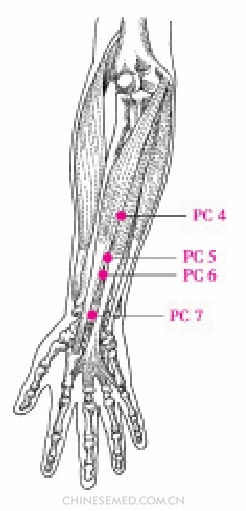
Location.method. With the patient’s fist clenched, the wrist supinated, and the elbow slightly fexed, the palmaris longus and fexor carpi radialis tendons become more prominent. The point is 1 cun distal to the midpoint of a line connecting PC 3 (qū zé) and PC 7 (dàlíng). If the palmaris longus tendon cannot be palpated, fnd the point medial to the fexor carpi radialis tendon.
Actions. Rectify qi and relieve pain, calm the heart and mind, clear heat from the ying level, and stop bleeding.
Indications. Heart pain, palpitations, chest pain, other heart and spirit disorders; coughing blood, vomiting blood, nosebleed, other heat bleeding syndromes; depression, mania; hard furuncle, stomachache; elbow and arm pain.
Manipulation. Acupuncture: Needle perpendicularly 0.5~0.8 cun. Local soreness and distention will be felt; numbness and distention can spread to the finger tips. Moxibustion: Use 3~5 cones of cone moxibustion, or use warming needle moxibustion for 20 minutes, or use a moxa stick for 10~20 minutes.
Precautions. Scarring moxibustion is forbidden.
Annotation. The point appeared in The Systematic Classic of Acupuncture and Moxibustion (ZhēnJiŭ Jiă Yĭ Jīng, 针灸甲乙经). The palmaris longus and fexor carpi radialis tendons are like a gate; the point, which is between them, is called xì mén, cleft door.
PC 5 (Jiān Shǐ, 间使)
Jing-river point
Location. On the medial aspect of the forearm between the palmaris longus and flexor carpi radialis tendons, 3 cun proximal to the palmar wrist crease (Pic. 3-63).
Location.method. See PC 4 (xì mén).
Actions. Prevent a malarial attack, calm the mind, and loosen the chest.
Indications. Heart pain, palpitations, chest and hypochondrium pain, other heart and chest disorders; stomachache, vomiting, other spleen and stomach disorders; heat disorders and malaria; depression, mania, epilepsy.
1 Jin ZX, Shi YR. Observations on the curative effects of bloodletting at PC 3 (qū zé) in 30 patients with acute gastroenteritis曲泽穴放血治疗急性胃肠炎30例疗效观察. China Community Doctors. 2006; 22(13): 49.
Manipulation. Needle perpendicularly 0.5~1.5 cun ; the needle tip can reach SJ 6 (zhī gōu) when deeply inserted. Local soreness and distention will be felt and electric-like numbness can radiate to the fnger tips. Moxibustion: Use 3~7 cones of cone moxibustion, or use warming needle moxibustion for 20 minutes, or use a moxa stick for 5~10 minutes.
Precautions. Avoid injuring the median nerve. Gentle manipulation is recommended. Scarring moxibustion is forbidden.
Annotation. The point appeared in The Spiritual Pivot-Fundamental Points (Líng Shū-Běn Shū,灵枢·本输). Shǐ means guide; jiān means space. The point is called jiān shǐ, space guide.
PC 6 (Nèi Guān, 内关)
Luo-connecting point; confuence point of the yinwei mai
Location. On the medial aspect of the forearm between the palmaris longus and flexor carpi radialis tendons, 2 cun proximal to the palmar wrist crease (Pic. 3-63).
Location.method. See PC 4 (xì mén).
Actions. Calm the heart and mind, harmonize the stomach, direct counterflowing qi downward, loosen the chest, calm and relieve pain.
Indications. Heart pain, palpitations, fright, vexation, insomnia, visceral agitation, depression, mania, epilepsy, other heart and mind disorders; chest and hypochondrial fullness and discomfort, stomachache, vomiting, hiccup, jaundice, pernicious vomiting during pregnancy, other spleen and stomach disorders; dizziness; elbow and arm pain.
Manipulation. Acupuncture: 1. Needle perpendicularly 0.5~1.5 cun ; the tip can reach SJ 5 (wàiguān) in deep insertion. Local soreness and distention will be felt and an electric-like numbness can extend to the finger tips. 2. Needle obliquely upward 1.0~2.0 cun. Local soreness and distention can spread to the elbow, armpit, and chest. This method can be used to treat trunk disorders. Moxibustion: Use 5~7 cones of cone moxibustion, or use warming needle moxibustion for 20 minutes, or use a moxa stick for 10~20 minutes.
Precautions. See PC 5 (jiān shǐ).
Annotation. The point appeared in The Spiritual Pivot-Channels (Líng Shū-Jīng Mài, 灵枢-经脉). Nèi means zang–fu organ; guān means gate. This point is the luo-connecting point of the hand jueyin channel and associates with the yinwei mai, which connects all yin channels. ‘Heart pain is the main pathological manifestation of the yinwei mai’. This key point for treating zang-fu organ dysfunction is called nèi guān, medial gate.
Modern clinical observation and research. In a blind, randomized study on PC 6 for postoperative nausea and vomiting, 119 infratentorial craniotomy patients received either transelectro-acustimulation (TEAS) or sham stimulation at P6 on the dominant side 30 minutes before anesthesia and up to 24 hours after surgery. Vomiting was significantly lessened in the TEAS group compared to control (22% vs. 41%, P=0.025), as was nausea, 6 (27% vs. 47%, P=0.019) and 24 hours (33% vs. 58%, P=0.008) after surgery. Need for rescue antiemetics was the same in both groups. The researchers concluded that TEAS at P6 can be an effective adjunct to drugs in such cases.1
PC 7 (Dà Líng, 大陵)
Shu-stream point; yuan-source point of pericardium
Location. On the medial aspect of the wrist between the palmaris longus and fexor carpi radialis tendons on the palmar wrist crease (Pic. 3-63).
1 Xu M, Zhou SJ, Jiang CC, Wu Y, Shi WL, Gu HH, et al. The effects of P6 electrical acustimulation on postoperative nausea and vomiting in patients after infratentorial craniotomy. J Neurosurg Anesthesiol. 2012; 24(4): 312-6.
Actions. Clear heat, calm the heart, relax the chest, harmonize the stomach, unblock channels, and invigorate blood.
Indications. Heart pain, palpitations, chest pain, heat sensation in the chest, shortness of breath, asthma, cough, other heart and lung disorders; vexation, insomnia, constraint syndrome, depression, mania, epilepsy, other brain disorders; stomachache, vomiting, vomiting of blood, other spleen and stomach disorders; headache, yellow eyes, red eyes, eye pain, pharyngitis, dry throat, mouth ulcer, bad breath, other fve sensory organ disorders; wrist pain, arm pain, wrist drop, other disorders of the wrist and its surrounding tissues.
Manipulation. Acupuncture: 1. Needle perpendicularly 0.3~0.5 cun. Local soreness and distention will be felt; sometimes an electric-like numbness radiates to the finger tips. 2. Needle obliquely into the carpal canal for carpal tunnel syndrome; local soreness and distention will be felt, and numbness and an electric-like shock can radiate to the fnger tips. 3. Bleed with a three-edged needle. Moxibustion: Use 3~5 cones of cone moxibustion, or use warming needle moxibustion for 20 minutes, or use a moxa stick for 10~20 minutes.
Precautions. See PC 5 (jiān shǐ).
Annotation. The point appeared in The Spiritual Pivot-Fundamental Points (Líng Shū-Běn Shū,灵枢·本输). Líng means hill. The protuberances of bone here resemble hills, giving the point its name, dà líng, large hill.
Modern clinical observation and research. In an RCT comparing acupuncture to steroids in carpal tunnel syndrome (CTS), patients were given four weeks of prednisolone (n=39) or eight 30-minute acupuncture treatments at PC 6 and PC 7 on the affected side (n=38). Pain, numbness, paresthesia, weakness/clumsiness, and nocturnal awakening improved in both groups at weeks 2 and 4 (P<0.01); acupuncture produced a significant decrease in nocturnal awakening (P=0.03) and distal motor latency (P=0.012) compared to steroids at week 4. These results suggest that short-term acupuncture is as effective as short-term low-dosage prednisolone for mild-to-moderate CTS and can be an effective alternative treatment when oral steroids are contraindicated.1
PC 8 (Láo Gōng, 劳宫)
Ying-spring point
Location. On the palm of the hand in the depression between the second and third metacarpal bones and proximal to the metacarpophalangeal joint (Pic. 3-64).
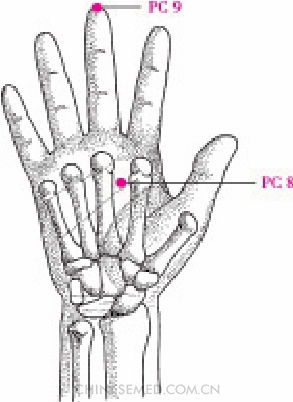
Location.method. Make a fist with the tips of the middle and ring fngers at the transverse crease of the palm; the point is below the tip of the middle fnger. (Pic. 3-65).
Actions. Release the exterior and eliminate vexation, clear heart heat, awaken the spirit, and open the orifices.
1 Yang CP, Hsieh CL, Wang NH, Li TC, Hwang KL, et al. Acupuncture in patients with carpal tunnel syndrome: A randomized controlled trial. Clin J Pain. 2009; 25(4): 327-33.
Indications. Heart pain, palpitations, chest and hypochondrial fullness and discomfort, hypochondrial pain, qi counterflow, other heart and chest disorders; vexation, depression, mania, epilepsy, infantile convulsion, other emotional and brain disorders; red urine, bloody stool, other heat syndromes; heat sensation of the palm, goose-web wind (tinea manuum), fnger numbness, profuse sweating of palms, other disorders of the running course.
Manipulation. Acupuncture: Needle perpendicularly 0.3~0.5 cun. Local soreness and distention can spread to the whole palm. Moxibustion: Use 3-5 cones of cone moxibustion, or use warming needle moxibustion for 20 minutes.
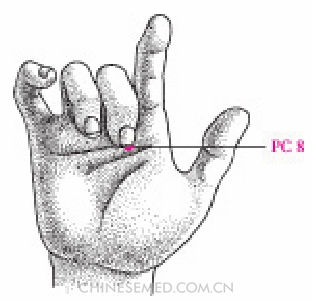
Precautions. 1. Because nerve endings are widely distributed on the palm, needling can be painful and must be done cautiously in elderly patients with defcient constitutions and in pregnant women. 2. Scarring moxibustion is forbidden.
Annotation. The point appeared in The Spiritual Pivot-Fundamental Points (Líng Shū-Běn Shū, 灵枢·本输). Láo means labor. When one works the fngers, the point is just below the tip of the middle fnger; hence the name láo gōng, labor center.
Modern clinical observation and research. In a case series on halitosis, daily acupuncture with reduction was given at PC 8 (láo gōng). Needles were retained for 30 minutes; twirled every 10 minutes. Of the 22 patients, 14 were cured within 1~6 treatments, 6 improved, and 2 did not benefit.1
PC 9 (Zhōng Chōng, 中冲)
Jing-well point
Location. On the middle fnger at the midpoint of the tip (Pic. 3-64, Pic. 3-66).
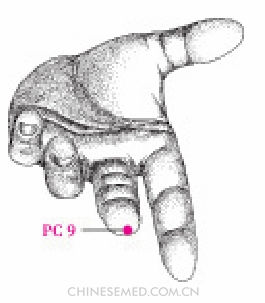
Location.method. With the palm up, the point is in the middle of the tip of the middle fnger, 0.1 cun from the margin of the nail.
Actions. Restore yang to save from collapse, awaken the spirit, and quicken collaterals.
Indications. Stroke and coma, syncope, summerheat stroke, infantile convulsions, other emergencies.
Manipulation. Acupuncture: 1. Needle shallowly to a depth of 0.1~0.2 cun. Local distention will be felt. 2. Bleed with a three-edged needle. Moxibustion: Use 1~3 cones of cone moxibustion, or use a moxa stick for 5~10 minutes.
Precautions. Caution must be used in pregnant women. Scarring moxibustion is forbidden.
Annotation. The point appeared in The Spiritual Pivot-Fundamental Points (Líng Shū-Běn Shū,灵枢·本输). It is named for its location. The hand jueyin pericardium channel qi runs between the hand taiyin lung and hand shaoyin heart channel on the upper limbs to the tip of the middle fnger; hence the name zhōng chōng, middle gushing.

